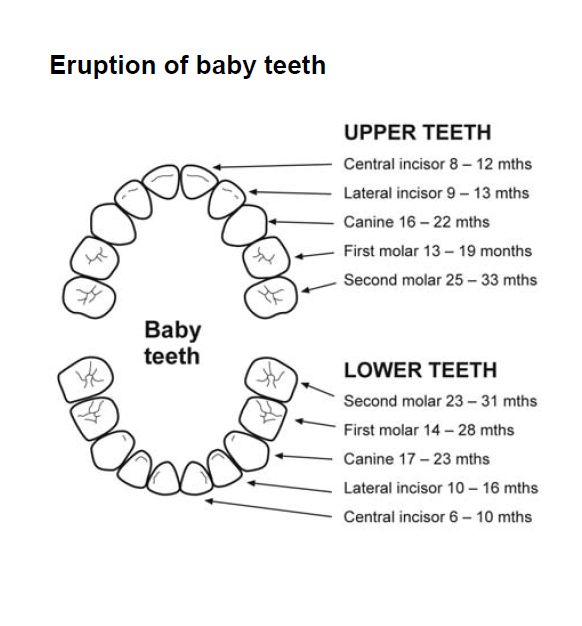Teething
Baby teeth allow children to eat, speak and smile.
Teething is where baby teeth start to break through the gums. Baby teeth first appear at around 6 months, but can vary from child to child. Children usually have all of their baby teeth by 3 years of age.
This diagram is a general guide to when the baby teeth should appear in the mouth.

Signs and symptoms
Babies can experience discomfort as their teeth start to break through their gums. Some babies and toddlers may experience teething problems, such as:
- red swollen gums
- irritability and restlessness
- flushed cheeks or fever
- dribbling
- finger and fist sucking.
Easing teething problems
Mild teething problems may be eased by letting the baby chew on objects such as:
- crusts of bread, chilled fruits or vegetables, or sugar/salt free rusks
- a chilled teething ring
- a parent/carer gently rubbing their gums with a clean finger.
Any teething problem should only be temporary. If pain persists and causes sleeplessness, ask your pharmacist, GP or child health nurse, or dental practitioner for advice.
Remember:
- Teething should never cause severe illness.
- If the child has a fever or diarrhoea, see your GP.
- A low fluoride toothpaste is recommended for children under 6 years of age.
Looking after baby teeth
Baby teeth help maintain the space for permanent teeth. Early loss of a baby tooth can reduce the space for the permanent tooth, which can cause crowded permanent teeth, so it's important to care for your baby's teeth as soon as they start to appear.
Find out more about oral health for babies and toddlers, including when and how to brush their teeth and tooth-friendly feeding.
Help and assistance
For more information:
- contact your dental practitioner
- find your nearest public dental clinic
- call 13 HEALTH (13 43 25 84) for confidential health advice 24 hours a day, 7 days a week
Other resources
- Oral health for babies and toddlers (0-2 years)
- Oral health for children (2-12 years)
- Your toddler's first dental visit


